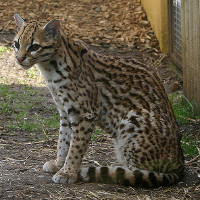 |
Ocelot |
|
He is a wild animal |
Origin |
Central and South America | |
Translation |
Francis Vandersteen |
| The possession of this animal is not authorized Royal Decree establishing the list of mammals not kept for production purposes that may be kept (M.B. 24.08.2009) |
| The Ocelot is a feline that lives in South and Central America. It is also found in southeast Texas in the United States. It lives in a variety of biotopes: swamps, mangroves, grasslands, bushes and tropical forests. It hunts at night on the ground and sometimes in trees. It is called Cunaguaro in Venezuela and Jaguatirica in Brazil. The Ocelot has an elongated body, with short legs and wide feet. The head is large, with round ears, yellow eyes and a pink nose. This feline weighs between 8 and 12 kg. Length from head to tip of tail varies from 92 to 144 cm. Coat color varies from yellow ochre to tawny in forest areas, and dull grayish hues in arid zones. The short coat has horizontally elongated eye-spots on the flanks. Black stripes line the tail, while small black spots mark the limbs. Two thick stripes cross each cheek and two thinner ones follow the forehead. The back of the ears is black with a central white or yellow patch. In the wild, the Ocelot can be confused with the Margay, whose coat is similar. However, the ocelot is much larger (the Margay weighs between 3 and 4 kg) and has a shorter tail. It is a good climber, like the larger puma, with which it shares most of its range. Its sense of smell is highly developed. The ocelot sleeps with its head resting on its outstretched front legs, like a dog. It is the only feline to sleep in this way. The ocelot hunts on the ground, although it generally lives in trees during the day. It normally hunts at night, but may continue to hunt in the morning, especially if it's raining or cloudy. The ocelot is a carnivore, its favorite prey being rodents such as rats, mice and agoutis. But its diet also includes birds, snakes, fish, lizards, bats, land crabs and larger animals such as monkeys, turtles, fawns, armadillos and anteaters. The ocelot population is estimated at between 800,000 and 1,500,000. It was once hunted for its fur, which was traded in a flourishing trade between the 1960s and 1970s, selling over 200,000 skins a year. Today, it is protected over most of its range (from the southern USA to Central and South America), and in some regions its population has increased. However, its habitat is still under threat from deforestation, which is creating new problems. There are twelve subspecies of ocelot, differentiated geographically : Leopardus pardalis pardalis (Linnaeus, 1758) - Amazonia Leopardus pardalis aequatorialis (Mearns, 1903) - northern Andes Leopardus pardalis albescens (Pucheran, 1855) - Mexico, Texas Leopardus pardalis maripensis Venezuela - Guyana Leopardus pardalis mearnsi (Allen, 1904) - Central America Leopardus pardalis melanurus Leopardus pardalis mitis (Cuvier, 1820) - Argentina, Paraguay Leopardus pardalis nelsoni (Goldman, 1925) - Mexico Leopardus pardalis pseudopardalis (Boitard, 1842) - Colombia Leopardus pardalis puseaus (Thomas, 1914) - Ecuador Leopardus pardalis sonoriensis (Goldman, 1925) - Mexico Leopardus pardalis steinbachi (Pocock, 1941) - Bolivia |






 English (United Kingdom)
English (United Kingdom)